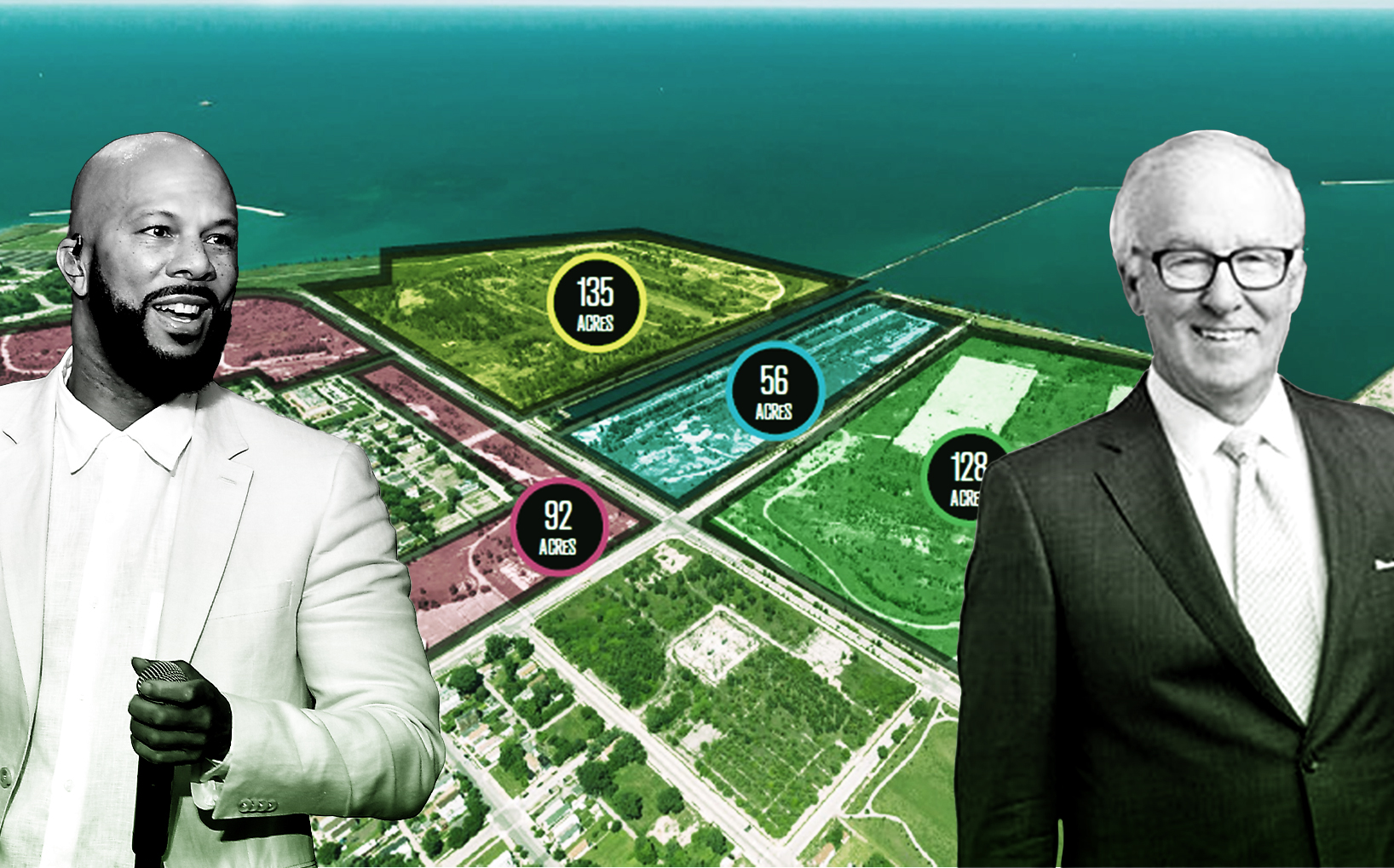There has never been a shortage of development ideas for U.S. Steel Corp.’s massive stretch of vacant land on the South Side, now marketed as 8080 Lakeshore Drive.
Two abandoned projects each involved building over 10,000 homes there, with one of the proposals including millions of square feet of commercial space along with a lakefront marina. Last summer, South Side-born rapper Common was also said to be interested, and had partnered with developers on another plan to bring hotels, entertainment venues and a movie studio. The site was also among five locations Chicago was considering for a casino, and the city planning commissioner suggested splitting the land into parcels then selling those off.
So with all that interest, why has the 415-acre former South Works steel mill sat empty for nearly 30 years? It’s complicated, and while real estate brokers, developers and local elected officials remain divided on what to build in an area about the size of Downtown Chicago, they agree it’s too important to remain empty.
Illinois is now in a near lockdown caused by the deepening coronavirus crisis, but industry pros believe the vast swath of land along Lake Michigan will play a vital role in Chicago’s future, both as a vehicle to attract more residents and as a means to expand its commercial core.
Sarah Ware, principal and managing broker at Ware Realty Group, said some of the challenges with developing the enormous site involve bridging the gap between the property and the surrounding community.
“So the question is, are you looking to develop U.S. Steel on its own as an island, or on your way to the 79th Street corridor in South Shore?” she said.
City Planning Commissioner Maurice Cox said in January that he thought South Works was far too large for one developer, and suggested chopping it up.
“When some are pointing out that it’s as big as the downtown, you start to understand the absurdity of turning that over to a single developer,” he said.
Big plans
Today, the empty site — U.S. Steel shut the plant in 1992 and demolished the buildings — still includes a fading sign partially covered by weeds. It shows a rendering of a $4 billion development a dozen years in the planning between U.S. Steel and Chicago-based developer McCaffery Interests. Abandoned in 2016, the project included a master-planned community with 13,000 homes, 17.5 million square feet of commercial space and a 1,500-slip marina. U.S. Steel pulled out when it was not able to finance the project.
“The site itself was certainly worth the time and effort to see if we can do something with it,” said Dan McCaffery, CEO of McCaffery Interests in a recent interview with The Real Deal.
There wasn’t anything disastrous that led to the split, he said. The steel company is not in the real estate business, McCaffery added. “They just wanted to put it up for sale and not stay in the partnership. But they’re still trying to sell it.” The company could use the cash infusion from a sale, after fallout from the coronavirus crisis prompted it to idle plants, cut its spending for the year and tap an $800 million credit line, the Street reported last week.
A few years ago at the South Works site, Emerald Living planned to build a multibillion-dollar project that would include 20,000 homes. A unit of Ireland-based WElink, Emerald Living partnered with Barcelona Housing Systems, a Spanish builder of modular housing. Those plans fizzled in May 2018, when Emerald Living pulled out over contamination at the site, though U.S. Steel said it had been given the all-clear on any environmental problems from the Environmental Protection Agency, according to reports at the time.
The $71 million mixed-use development plan from the group led by Common included a 128-acre film production campus with up to 20 sound stages, plus a sports and recreation complex affiliated with golf legend Greg Norman. The development team included Los Angeles-based developer Sam Nazarian, entertainment management company RoadTown Enterprises, New York-based Morris Nasser and Chicago-based DL3 Realty.
Little has changed at the site since it was closed, though modest improvements have been made. In 2002, the Chicago Park District acquired 16.5 acres from U.S. Steel, which was eventually transformed into Steelworkers Park with the collaboration of McCaffery Interests.
A spokesperson for U.S. Steel declined to comment on the property or any future plans for it.
Marketing pitch
Shortly after ending its agreement with McCaffery, U.S. Steel hired Cushman & Wakefield to market the site, which is 10 miles south of Downtown. Cushman billed it as one of the largest contiguous infill- and waterfront-parcels for sale in the United States. Cushman remains the broker, but declined to comment.
Anthony Hardy, agent at Marcus & Millichap, said potential environmental remediation concerns remain for any future developer.
“Typically, those steel plants put out a lot of waste and pollution, and with one of the largest steel plants in America making steel in that location for over 100 years, it’s going to be a big challenge in terms of the environmental cleanup,” he added. Meanwhile, McCaffery said its sheer size is problematic. “It’s huge. So that alone is a challenge.”
Ware also questioned whether splitting up the development into different parcels, and creating different proposals, would work. “I think that would be a challenge. You want something to be in tandem with what the overall vision is,” she said. “It can’t just be a regular developer or master planner. McCaffery to me was their best bet right now, but the hope is somebody can come in of that level to start it.”
“Bite-sized pieces”
Others, like Hardy, believe separating the parcels is the way to ensure construction commences.
“Part of the issue is that they keep trying to have one huge developer as opposed to breaking it into more bite-sized pieces, and get more developers involved,” he said.
Hardy said he was excited about the prospects of the development. His family even toured the site and had planned to buy a home in the future development. “I really like the location,” he said. “I think it has a lot of potential.” He would also like to see some type of housing assistance to help make the homes affordable for more people in the community.
McCaffery, who called South Works a “magnificent property,” likened it to a certain popular destination spot in Florida. “Orlando was a swamp until Disney developed it,” he noted. But he acknowledged with South Works, “despite the best of intentions by the best of people, there really hasn’t been an overall political push.” If ground is going to ever be broken on a massive project at the property, he added, “it’s going to have to have a huge public effort.”




